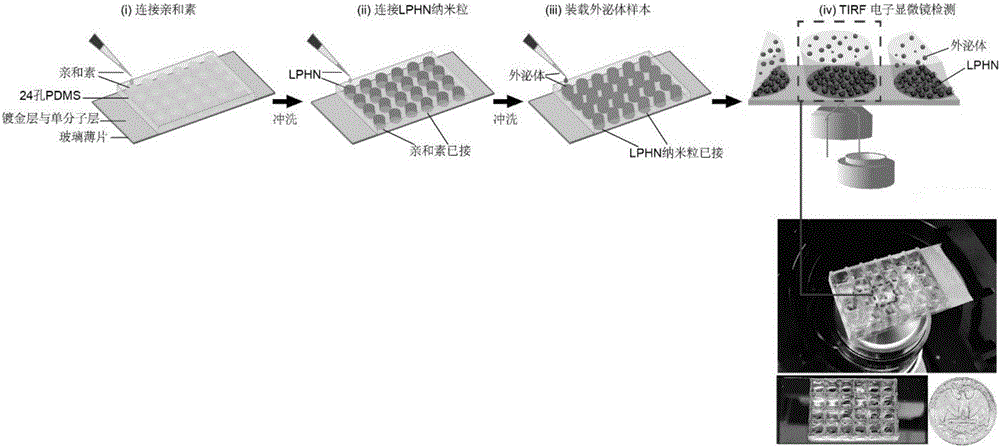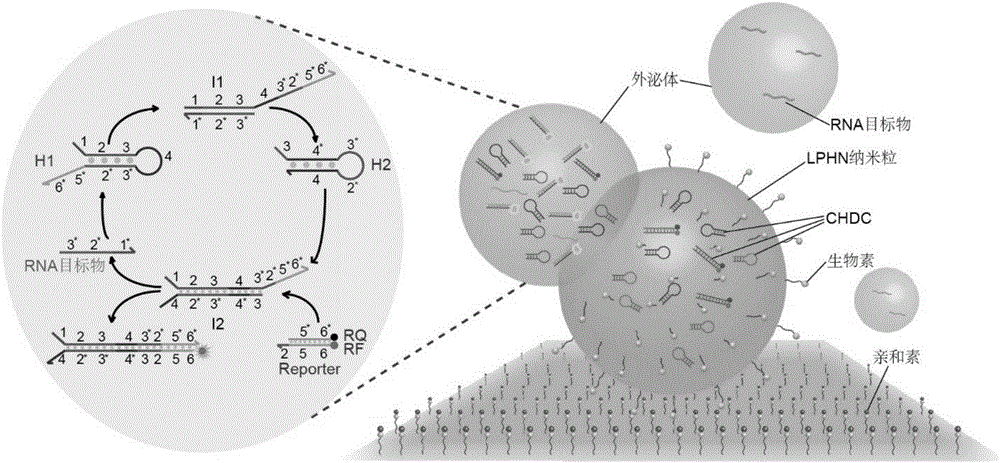Immune lipid-polymer hybridized nanoparticle biological chip and preparation method and application thereof in disease detection
A biochip, polymer technology, applied in measurement devices, instruments, scientific instruments, etc., can solve the problems of low sensitivity, no fluorescence signal amplification, no cell membrane fusion, etc., and achieve high selectivity and sensitivity. Effect
- Summary
- Abstract
- Description
- Claims
- Application Information
AI Technical Summary
Problems solved by technology
Method used
Image
Examples
Embodiment 1
[0074]Preparation and physical and chemical properties characterization of lipid-polymer hybrid nanoparticle biochip.
[0075] Example 1 describes a simple method to prepare a lipid-polymer hybrid nanoparticle biochip ( Figure 1a ,b). A gold-coated glass substrate was immersed in an ethanol solution of βME and SH-PEG-Biotin to form a self-assembled monolayer. The PDMS template was immobilized on the self-assembled monolayer by microcontact paste technology to make a chip. The hairpin DNA catalytic loop (H1, H2, and Reporter) is encapsulated in lipid-polymer hybrid nanoparticles, which are anchored to the chip surface by biotin-avidin-specific affinity. Cationic lipid-polymer hybrid nanoparticles capture anionic exosomes through electrostatic interaction and fuse with them to form nanoscale complexes, so that the hairpin DNA catalytic circuit (CHDC) in nanoparticles and the exosomes in exosomes The target RNA hybridizes and produces an amplified fluorescent signal. The targ...
Embodiment 2
[0078] Lipid-polymer hybrid nanoparticle biochip for artificial exosome detection.
[0079] In this example, artificial exosomes ( Figure 2a ). Based on the fact that natural exosomes contain a small amount of target RNA and other RNAs, our artificial exosomes contain 1% GPC DNA and 99% miR54-DNA. Figure 2b -i shows the comparison of the sensitivity results of the detection of artificial exosomes by liposome biochips and lipid-polymer hybrid nanoparticle biochips respectively encapsulating molecular beacons and hairpin DNA catalytic circuits (CHDC). The results showed that the sensitivity of the lipid-polymer hybrid nanoparticle biochip wrapped with the hairpin DNA catalytic circuit (CHDC) was 600 times higher than that of the liposome biochip wrapped with molecular beacons, showing higher sensitivity.
Embodiment 3
[0081] Lipid-polymer hybrid nanoparticle biochip for detection of GPC1mRNA and KRAS in pancreatic cancer cells G12D mRNA.
[0082] Example 3 includes the application of lipid-polymer hybrid nanoparticle biochips containing molecular beacons or hairpin DNA catalytic circuits (CHDC) to distinguish pancreatic cancer cells (AsPC-1) from pancreatic normal cells (HPDE6-C7), And compared with liposome biochip. GPC1mRNA and KRAS G12D mRNA is an effective biomarker for pancreatic cancer cells and pancreatic cancer mutant cells, respectively. Figure 3a -d demonstrates that encapsulation of the hairpin DNA catalytic circuit (CHDC) targeting GPC1 mRNA can effectively differentiate pancreatic cancer cells from normal pancreatic cells. Figure 3e -f show package for KRAS G12D The hairpin DNA catalytic circuit (CHDC) of mRNA can effectively distinguish pancreatic cancer mutant cells from normal pancreatic cells.
PUM
| Property | Measurement | Unit |
|---|---|---|
| molecular weight | aaaaa | aaaaa |
| particle size | aaaaa | aaaaa |
| particle size | aaaaa | aaaaa |
Abstract
Description
Claims
Application Information
 Login to View More
Login to View More - R&D
- Intellectual Property
- Life Sciences
- Materials
- Tech Scout
- Unparalleled Data Quality
- Higher Quality Content
- 60% Fewer Hallucinations
Browse by: Latest US Patents, China's latest patents, Technical Efficacy Thesaurus, Application Domain, Technology Topic, Popular Technical Reports.
© 2025 PatSnap. All rights reserved.Legal|Privacy policy|Modern Slavery Act Transparency Statement|Sitemap|About US| Contact US: help@patsnap.com



